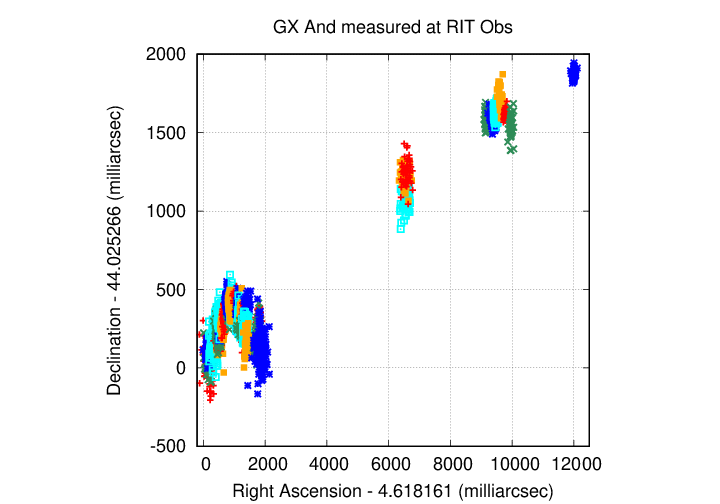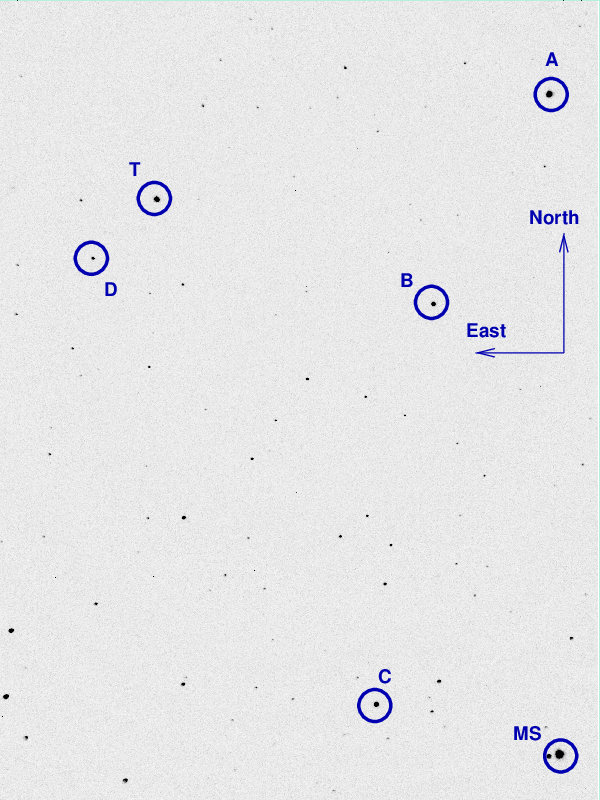
On the night of Jun 24/25, 2024, under good conditions, I acquired images of the recurrent nova T CrB. This star undergoes outbursts at long intervals of 80 years or so. Its next outburst is predicted to occur soon, perhaps in 2024, and so I've joined the crowd who are monitoring it.
The object was still in its quiescent state tonight, at approximate V = 10.33.
I also acquired some images of my two long-term parallax targets, GX And and Ross 248. These are the first observations of these two stars since December of last year.
This recurrent nova brightens from by about 8 magnitudes (!), from V = 10 to about V = 2, around every 80 years. Will we see another outburst this summer?
These observations involved:
Notes from the night:
The picture below shows a cropped image of the field of T CrB from Jun 14/15, 2024. The field of view is about 20 arcminutes across.

I've marked the location of several comparison stars, with magnitudes and names taken from the AAVSO's chart.
star name B V
------------------------------------------------------
A 000-BJS-901 11.190 10.566
B 000-BBW-805 11.840 11.187
C 000-BPC-198 13.049 12.336
--------------------------------------------------------------------------
When the target is centered, the finder TV shows this field:

Here's the sky background over the course of the run. Note the brief clouds.
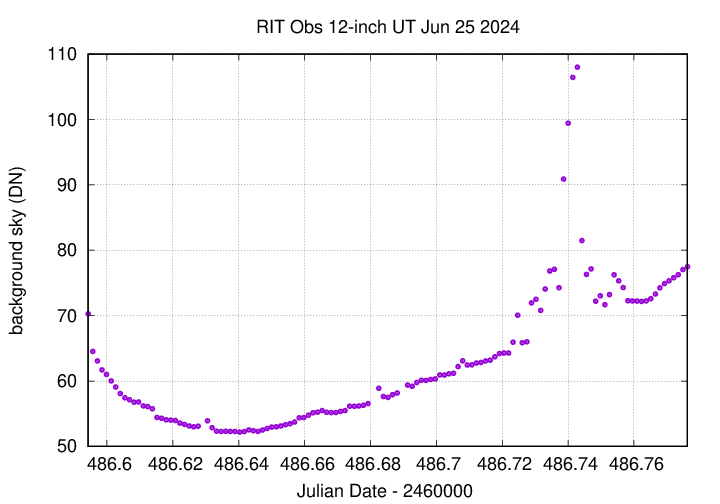
The FWHM was steady in V.
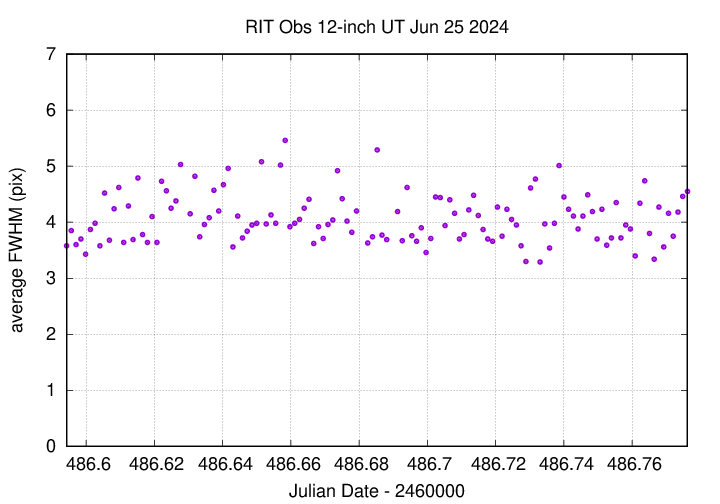
The graph below shows changes in the photometric zeropoint of an ensemble solution of the instrumental magnitudes over the course of the run. Note light clouds late in the run.

Using aperture photometry with a radius of 7 pixels in V filter (binned 4x4, each pixel is 1.036 arcsec, so a radius of 7.3 arcsec), and 7 pixels in B filter (binned 4x4, each pixel is 1.036 arcsec, so a radius of 7.3 arcsec), I measured the instrumental magnitudes of a number of reference stars and the target. Following the procedures outlined by Kent Honeycutt's article on inhomogeneous ensemble photometry, I used all stars available in each image to define a reference frame, and measured each star against this frame.
Sigma-vs-mag plots show that the floor in V-band was about 0.004 mag, which is good. It was 0.005 in B-band.
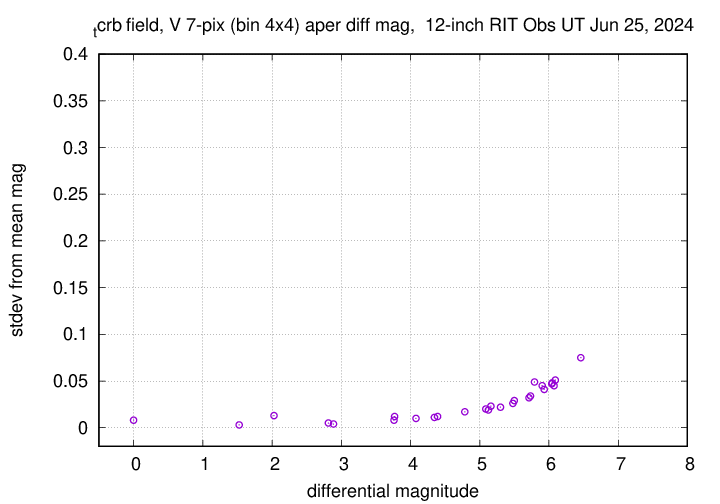
The measurements show relatively steady brightness. The B-band showed a bit more action, but nothing major.
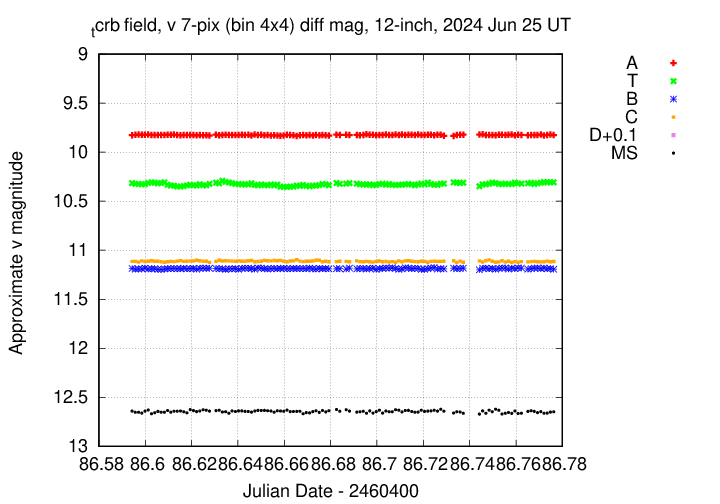
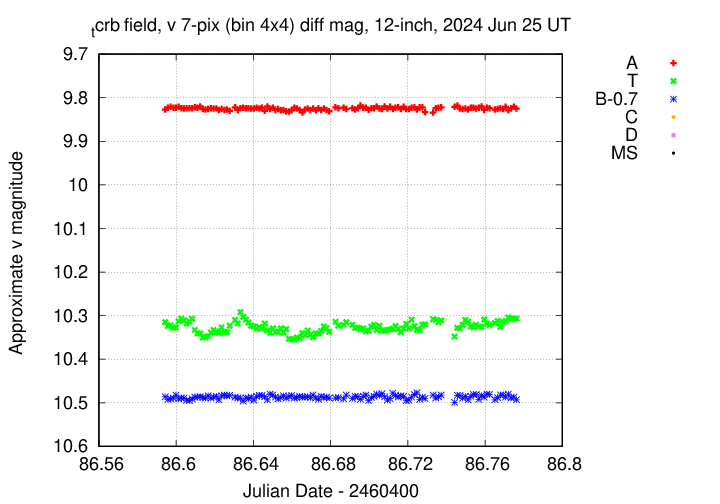
You can download my measurements below. A copy of the header of the file is shown to explain the format. First, the V-band data.
# Measurements of T_Crb made at RIT Obs, UT 2024 Jun 25, # in good conditions, # by Michael Richmond, # using Meade 12-inch LX200 and ASI 6200MM. # Exposures 30 seconds long, v filter. # Tabulated times are midexposure (FITS header time - half exposure length) # and accurate only to +/- 1 second (??). # 'mag' is a differential magnitude based on ensemble photometry # using a circular aperture of radius 7 pix = 7.2 arcseconds. # which has been shifted so AAVSO 000-BBW-805 has mag=11.187 # which is its V-band magnitude according to AAVSO chart X36711CB. # # UT_day JD HJD mag uncert Jun25.09428 2460486.59428 2460486.59727 10.315 0.004 Jun25.09567 2460486.59567 2460486.59866 10.324 0.004 Jun25.09707 2460486.59707 2460486.60006 10.322 0.003
Now, the B-band data.
# Measurements of T_Crb made at RIT Obs, UT 2024 Jun 25, # in good conditions, # by Michael Richmond, # using Meade 12-inch LX200 and ASI 6200MM. # Exposures 60 seconds long, b filter. # Tabulated times are midexposure (FITS header time - half exposure length) # and accurate only to +/- 1 second (??). # 'mag' is a differential magnitude based on ensemble photometry # using a circular aperture of radius 7 pix = 7.2 arcseconds. # which has been shifted so AAVSO 000-BBW-805 has mag=11.84 # which is its B-band magnitude according to AAVSO chart X36711CB. # # UT_day JD HJD mag uncert Jun25.09498 2460486.59498 2460486.59797 11.680 0.006 Jun25.09637 2460486.59637 2460486.59936 11.681 0.006 Jun25.09777 2460486.59777 2460486.60076 11.682 0.006
I've submitted these measurements to the AAVSO.
This is one of the stars that a capstone student may study over the next year in a project involving parallax. Ross 248 is a relatively faint red star surrounded by many other stars of similar brightness, so it's a good candidate for high-precision parallax measurements.
These observations involved:
The object is (currently) near position
RA = 23:41:55.27 Dec = +44:10:06.38 (J2000)
A chart of the field is shown below. The size of the chart is about 41 x 27 arcminutes. The noisy area at right (West) is the shadow of the guider's pickoff mirror.
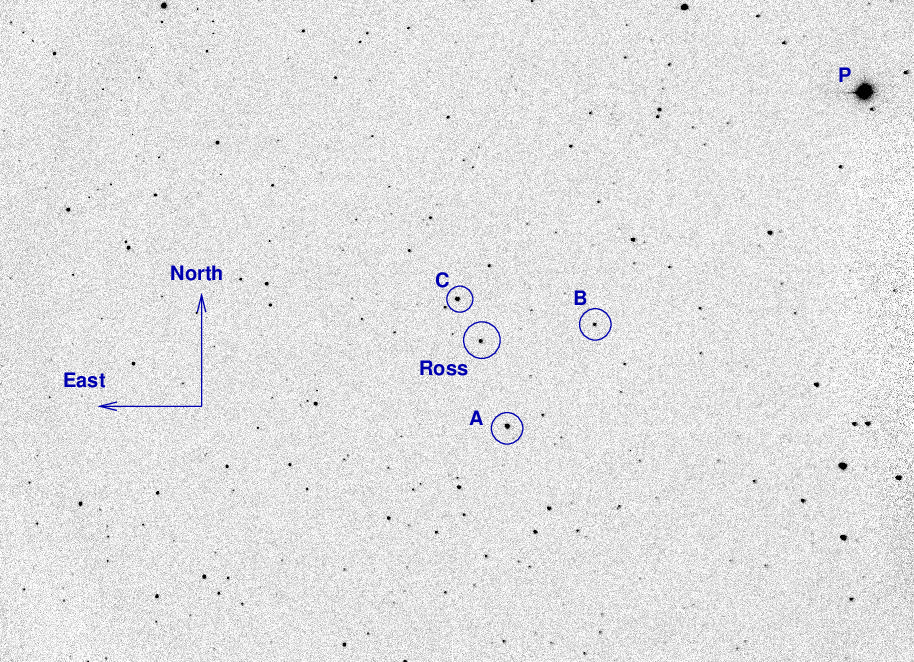
I've marked the location of several comparison stars.
star UCAC4 B V r ------------------------------------------------------------------------- A UCAC4 671-120730 12.617 10.689 B UCAC4 671-120688 C UCAC4 671-120749 10.987 10.663 P kappa And 4.06 4.14 --------------------------------------------------------------------------
I took a photo of the finder TV's screen when pointing to Ross 248; this could be a useful reference for the future:
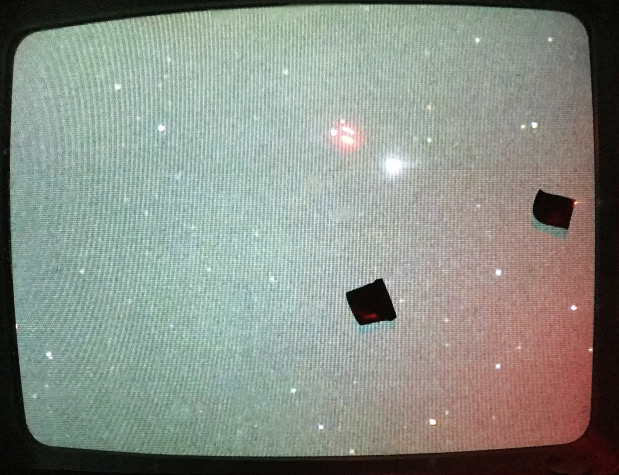
In order to get the best results for Ross 248, it is necessary to use only a subset of the stars in the camera's full field of view. For this evening's data, I chose the "intermediate" subset, and restricted matches to those stars within about 11 arcminutes of the target.
Here are the positions I've measured so far. The most recent measurements are at the bottom of this plot.

Like Ross 248, GX And is a nearby (binary) star which will be the target of a parallax project in the coming year. One of the two components is bright -- about mag V = 8 -- so one must use short exposures to prevent it from saturating the detector. That may mean that this system isn't as easy to measure as Ross 248 or some others.
These observations involved:
The object is currently close to this position:
RA = 00:18:28.4 Dec = +44:01:31 (J2000)
but it does have a very high proper motion.
A chart of the field is shown below. The size of the chart is about 41 x 27 arcminutes. The noisy area at right (West) is the shadow of the guider's pickoff mirror.
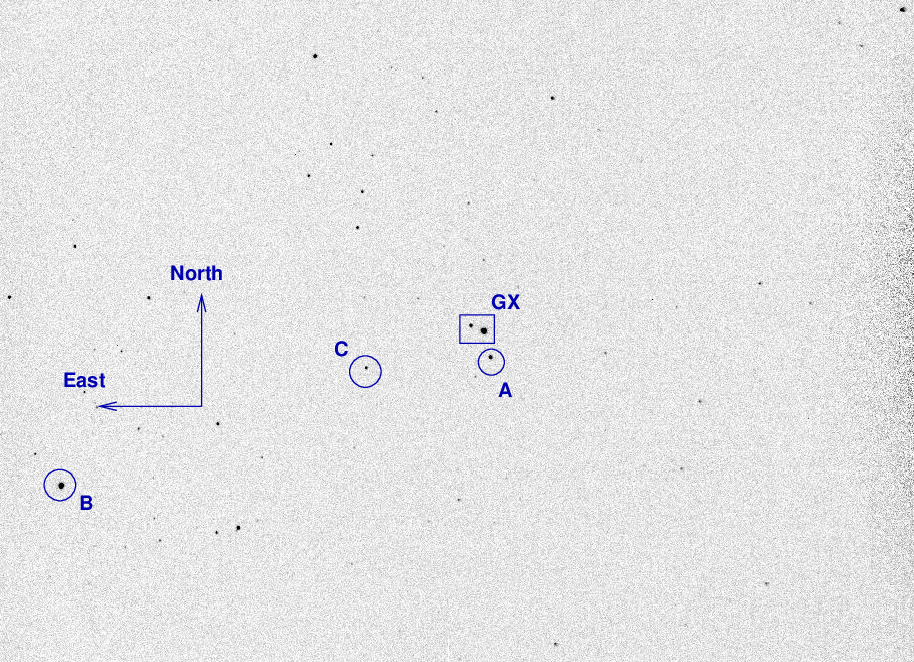
The two components of the GX And binary sit inside the box. I've marked the location of several comparison stars as well.
star UCAC4 B V r ----------------------------------------------------------- A 671-001473 9.939 9.790 B 670-001639 9.413 8.472 C 671-001509 12.712 11.421 11.001 -----------------------------------------------------------
I took a photo of the finder TV's screen when pointing to GX And; this could be a useful reference for the future:

Using the same techniques as described for earlier nights, I matched detected stellar positions to the Gaia DR2 catalog. In this case, I used only stars within a "smaller" subset of the full catalog around the target, those no more than 10 arcminutes away from it. Using a catalog contains stars out to 20 arcminutes away caused the matching procedures to fail most of the time.
The target is moving to the upper-right with time, and clearly shows the back-and-forth motion due to parallax.
